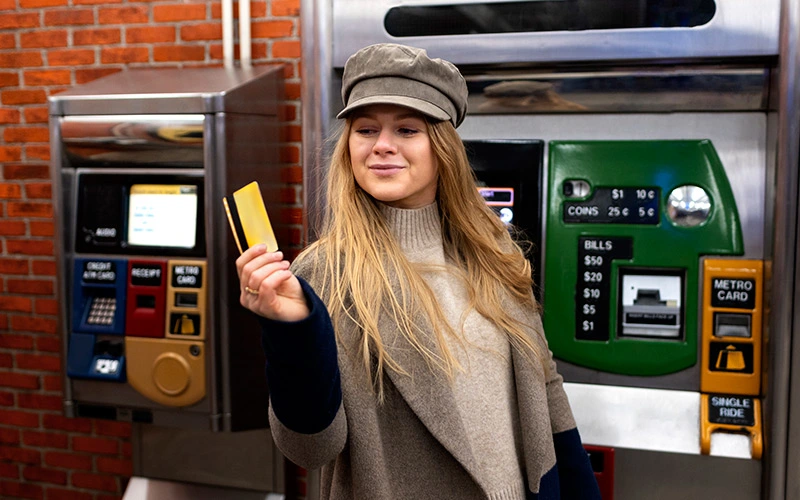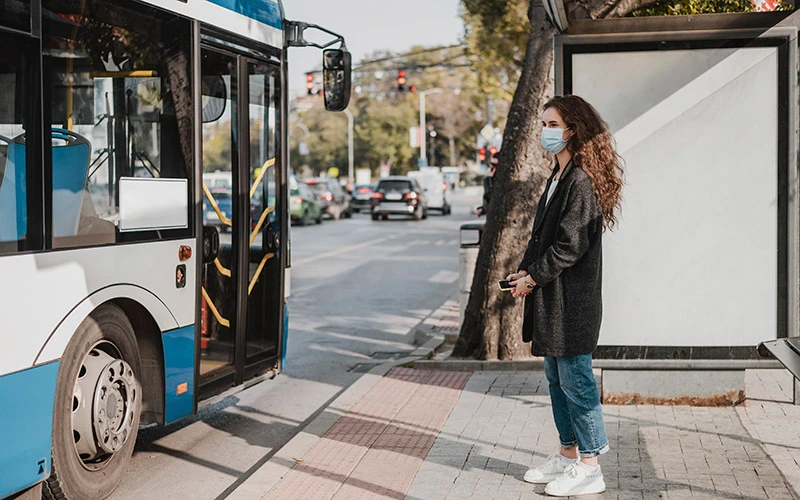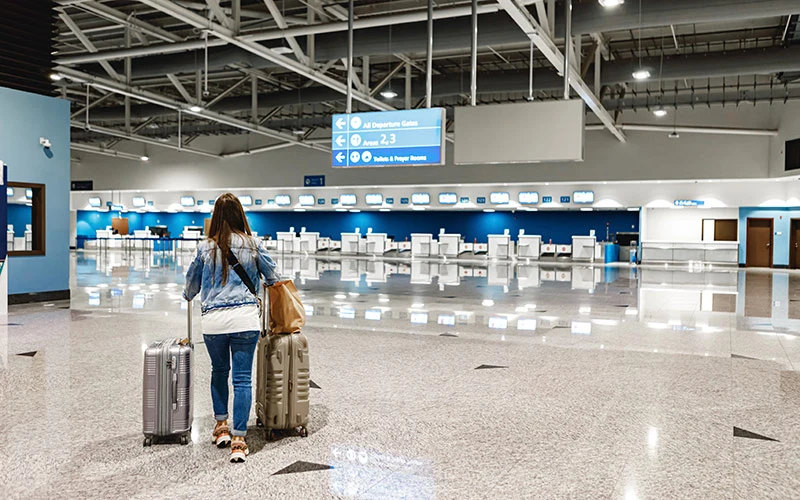When you first reach New York, the city’s public transportation system can seem daunting. Most first-timers fixate on the subway, but the system’s reach is broader than the trains. To help you have an easier trip, it’s also wise to master a few unwritten rules that most guidebooks won’t tell you, and grasp how the system’s quirks can help you save time or land in trouble. After a bit, you’ll get the hang of it and end up on connected streets nearly everywhere in the city.
New York Subway System- Getting Around the City
The subway is the workhorse of New York public transportation, with 472 stations and 24 lines that run around the clock. Locals are known to use apps to find out if there are any delays and late-night changes. The subway is far more than a tourist attraction; it’s the quickest way to get from one place to another, bypass surface traffic and observe how the city truly works.
Metro Tickets, OMNY, and MetroCards

- You can tap in with OMNY using your phone or any contactless bank card, or buy a physical metro ticket in New York at machines in every station.
- Unlimited weekly and monthly passes are only available on MetroCards, not OMNY. OMNY users benefit from weekly fare capping, after 12 rides, all rides in that week are free.
- Check the LED sign and the platform before you get on. As some lines may run express or local trains, and some trains do not stop at certain stations.
Subway Map and Navigation
- It’s not an exact city map, distances on paper can be very different than in reality.
- Stations with multiple lines can have confusing transfers, so look for posted signs and do not assume that all entrances lead to every train.
- Major hubs like Times Square, Grand Central, and Atlantic Avenue serve as key transfer points.
What to Watch For
- Rush hour trains fill up fast between 7:30–9:30 am and 4:30–6:30 pm.
- Night and weekend schedules are unpredictable, service changes are frequent, and sometimes only announced last minute.
- Only some stations have elevators or escalators; check accessibility if you have heavy luggage.
MTA Buses—A Citywide Network With Hidden Advantages

The city is served by the MTA, public transport in New York, which runs a staggering number of buses throughout the city’s bus system. Buses extend the subway’s reach, link neighbourhoods directly and provide critical cross-town service that is difficult for trains to match.
Understanding the Bus Network
- Routes are labeled by borough: “M” for Manhattan, “B” for Brooklyn, “Q” for Queens, “Bx” for the Bronx, and “S” for Staten Island.
- Local buses stop at every block or two, while Select Bus Service (SBS) lines offer faster service with fewer stops and off-board fare payment.
- Express buses run from outer boroughs into Manhattan, usually during rush hours.
How to Ride and Pay
- Board at the front and tap with OMNY or dip your MetroCard. No need for exact change; buses don’t take cash.
- Unlimited passes on MetroCard work for both buses and subways, but only one rider per card is allowed.
- If using SBS, pay at the machine before you board, keep your receipt, and board at any door.
Smart Ways to Use Buses
- Crosstown buses in Manhattan are the quickest way east to west, much faster than switching subway lines.
- Late-night buses are sometimes safer and better lit than deserted subway stations.
- Real-time bus arrivals show on digital screens at many stops and in most map apps.
Airport Connections—Your Guide to Smart Transfers

Airport travel can be stressful, but public transportation in NYC connects both JFK and LaGuardia to the subway and bus systems.
JFK Airport
- Use the AirTrain to reach Jamaica or Howard Beach stations for subway or Long Island Rail Road connections.
- AirTrain is not covered by any New York transportation pass; pay separately at the exit.
- Travel time to Manhattan is about 60-90 minutes, depending on subway wait times and your final stop.
Choosing the Right Pass for Your Trip
A New York transportation pass can save time and money, but only if you pick the right one for your plans.
Key Points for Metro Tickets and Passes
- Pay-per-ride works for short stays; unlimited passes make sense for daily travel.
- OMNY fare capping kicks in automatically, but you can’t get an unlimited ride card on OMNY yet.
- The NYC subway price for a single ride is $2.90, so frequent travelers benefit from unlimited passes.
- MetroCard unlimited passes are locked to one person, and sharing is not allowed.
Local Rules and Real Etiquette
New York moves fast, but there’s an unspoken code to make travel smoother for everyone.
Rules Nobody Tells You
- Don’t stand in the subway doorway or block bus aisles with bags.
- Headphones are essential. No loud music or phone calls.
- Most locals avoid eye contact; it’s not rude, just a habit.
- Give priority seating to those who need it without being asked.
Timing Matters for Stress-Free Rides
The most efficient way to navigate New York can vary from morning to evening. For something quieter, travel after 10 a.m. and before 4 p.m. or after 7 p.m. on Monday through Friday. If you’re wondering about the best time to visit New York, spring and early fall offer pleasant weather, fewer crowds, and a more relaxed pace for public transport. As for weekend afternoons, there’s significantly less of a line than in the morning, but do check for any service changes, especially around holidays or particular citywide events.
Special Notes for Visa and Official Visits
If your travel involves a US visa appointment or for those on a B2 Visa USA, the subway is the best way to get around New York, to consulates or government buildings, especially during unpredictable midtown traffic. They are also less crowded early in the mornings.
FAQs
How do you pay for public transport in NYC?
Pay for public transport in NYC with OMNY by tapping a contactless credit or debit card, smartphone, or smartwatch at the turnstile or on the bus. You can buy a Metro ticket in NYC from machines in every subway station. It works for both subways and buses.
How much does a 7-day MetroCard cost in NYC?
A 7-day unlimited MetroCard costs $34. This card allows unlimited subway and local bus rides for seven consecutive days. It’s the best value if you plan to travel frequently around New York City and want the convenience of unlimited journeys.
Can you use Apple Pay for the NYC subway?
Yes, you can use your iphone for payment at kiosks and machines. Just hold your iPhone or Apple Watch to the OMNY reader at the subway turnstile or bus entry. The ticket price will automatically be deducted from your linked account.
How do visitors use the subway in NYC?
They do so by tapping OMNY with a contactless card or mobile wallet, or by buying a MetroCard at vending machines in stations. As always, check signs for train directions and service changes. Make sure to get a subway map or an app to help you get around.
Is a 7-day MetroCard worth it?
It’s worth getting a 7-day MetroCard if you’ll be riding the subway or buses more than a few times every day for a week in New York. Shoot, it’s even a money saver over the cost of each ride and you can use it as much as you want throughout the city.
Conclusion
Once you step off the train or bus, the city welcomes you with an endless amount of things to do in New York. Get off at Central Park for museums, at Lower Manhattan for food tours and a river view. And now with some inside info, all of a sudden the subway and the buses aren’t just how you get around, they’re the keys to the whole city and the whole scene.
